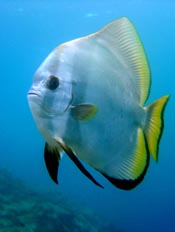The Sant Ocean Hall Fun Facts
- Giant Clams (Tridacna gigas) are the world's largest bivalve species. Native to the South Pacific and Indian Ocean, giant clams reach 136-227kg (300-500 lbs).
- Some of the microscopic ocean organisms called dinoflagellates produce toxins that create dangerous "red tides" in coastal waters.
- Did you know that some fish can walk? The fins of the bottom-dwelling monkfish (Lophis piscatorius) are modified into leg-like appendages, letting it walk along the ocean floor.
- The longest mountain range on Earth is formed in part by the mid-ocean ridge system in the Northern Mid-Atlantic. Its highest peaks poke above the water, forming islands such as Iceland.
- Mauna Loa in the North Pacific is the Earth's tallest mountain. Formed by an undersea volcano, it rises 9,170 m (30,000 ft) from the seafloor.
- Coccoliths are very small photosynthetic organisms. After they die, their empty shells accumulate on the seafloor as chalk.
- Some of the Earth's tallest forests are in the ocean, dominated by giant kelp. Kelp can reach 100 meters in height (328 feet).
- Sailfish, considered the fastest ocean fish, can reach speeds of 109 kph (68 mph) when leaping from the water.
- Scientists try to make sense of the incredible diversity found in the ocean by organizing marine organisms by who they are related to, where they live, and how big (or small) they are.
- About 370 million years ago, New York was covered by a seaway populated by marine organisms like a sponge (Hydnoceras tuberosum) whose skeleton was made of glass.
- Currents continually mix and churn ocean water. The sea never rests. Ocean currents carry water around the globe from top to bottom.
- Want to visit Earth's deepest valley? Longest mountain range? Biggest volcano? Put on your bathing suit, because these are all found at the bottom of the ocean.
- Ocean dwellers use the entire depth of the ocean. They live in a three-dimensional world that's full of life from top to bottom.
- Earth's ocean spans several "basins" - Pacific Ocean, Indian Ocean, Atlantic Ocean, Arctic Ocean, and Southern Ocean. People have named these basins differently, but they are all part of a single, complex body of water.
- The Pacific Ocean's Mariana Trench is 10,920 m (35,830 ft) deep at its deepest point - the deepest valley on Earth.
- If you could drain away the ocean's water, you'd see a rugged terrain of towering cliffs, flat plains stretching out of sight, and vents spewing heat and chemicals from deep underground.
- While you’re reading this, the process of evolution is still going on. Speciation (evolution of new species) in the ocean is continual, though gradual.
- The ocean is home to almost every major form of life - from the tiny to the titanic, from the familiar to the undiscovered.
- The North Atlantic Right Whale model hanging from the ceiling of the Ocean Hall is based on a real, living whale. Her name is Phoenix, and you can learn more about her story here.
[ TOP ]
